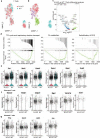This is a preprint.
Loss of cis-PTase function in the liver promotes a highly penetrant form of fatty liver disease that rapidly transitions to hepatocellular carcinoma
- PMID: 38014178
- PMCID: PMC10680637
- DOI: 10.1101/2023.11.13.566870
Loss of cis-PTase function in the liver promotes a highly penetrant form of fatty liver disease that rapidly transitions to hepatocellular carcinoma
Abstract
Obesity-linked fatty liver is a significant risk factor for hepatocellular carcinoma (HCC)1,2; however, the molecular mechanisms underlying the transition from non-alcoholic fatty liver disease (NAFLD) to HCC remains unclear. The present study explores the role of the endoplasmic reticulum (ER)-associated protein NgBR, an essential component of the cis-prenyltransferases (cis-PTase) enzyme3, in chronic liver disease. Here we show that genetic depletion of NgBR in hepatocytes of mice (N-LKO) intensifies triacylglycerol (TAG) accumulation, inflammatory responses, ER/oxidative stress, and liver fibrosis, ultimately resulting in HCC development with 100% penetrance after four months on a high-fat diet. Comprehensive genomic and single cell transcriptomic atlas from affected livers provides a detailed molecular analysis of the transition from liver pathophysiology to HCC development. Importantly, pharmacological inhibition of diacylglycerol acyltransferase-2 (DGAT2), a key enzyme in hepatic TAG synthesis, abrogates diet-induced liver damage and HCC burden in N-LKO mice. Overall, our findings establish NgBR/cis-PTase as a critical suppressor of NAFLD-HCC conversion and suggests that DGAT2 inhibition may serve as a promising therapeutic approach to delay HCC formation in patients with advanced non-alcoholic steatohepatitis (NASH).
Figures






















Similar articles
-
TAZ-induced Cybb contributes to liver tumor formation in non-alcoholic steatohepatitis.J Hepatol. 2022 Apr;76(4):910-920. doi: 10.1016/j.jhep.2021.11.031. Epub 2021 Dec 11. J Hepatol. 2022. PMID: 34902531 Free PMC article.
-
FOXA3 induction under endoplasmic reticulum stress contributes to non-alcoholic fatty liver disease.J Hepatol. 2021 Jul;75(1):150-162. doi: 10.1016/j.jhep.2021.01.042. Epub 2021 Feb 4. J Hepatol. 2021. PMID: 33548387
-
Metabolic signatures across the full spectrum of non-alcoholic fatty liver disease.JHEP Rep. 2022 Mar 26;4(5):100477. doi: 10.1016/j.jhepr.2022.100477. eCollection 2022 May. JHEP Rep. 2022. PMID: 35434590 Free PMC article.
-
Molecular Mechanisms: Connections between Nonalcoholic Fatty Liver Disease, Steatohepatitis and Hepatocellular Carcinoma.Int J Mol Sci. 2020 Feb 23;21(4):1525. doi: 10.3390/ijms21041525. Int J Mol Sci. 2020. PMID: 32102237 Free PMC article. Review.
-
The ménage à trois of autophagy, lipid droplets and liver disease.Autophagy. 2022 Jan;18(1):50-72. doi: 10.1080/15548627.2021.1895658. Epub 2021 Apr 2. Autophagy. 2022. PMID: 33794741 Free PMC article. Review.
References
Publication types
Grants and funding
LinkOut - more resources
Full Text Sources
